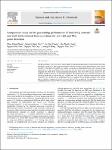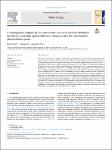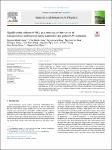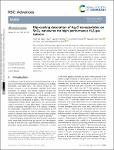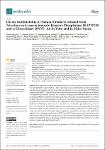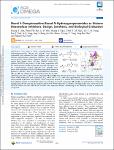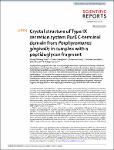Search
Author
- Quan-Hoang Vuong (27)
- Anh-Tuan Le (17)
- Vuong QH (12)
- Anh D. Phan (11)
- next >
Subject
- Electrospinning (8)
- Nanoparticles (6)
- Compound droplet (5)
- Machine learning (5)
- next >
Date issued
- 2020 - 2022 (482)
- 2010 - 2019 (19)
- 2002 - 2009 (1)
Has File(s)
Search Results
The design of hetero-nanojunctions can greatly amplify the gas-sensing performance of conventional metal oxide gas sensors. In this study, the composite nanofibers (NFs) of ZnO–SnO2 internal heterojunctions (HJs) and the mixed NFs of ZnO/SnO2 external HJs were realized by using the electrospinning technique. Then, the gas-sensing characteristics of the as-synthesized NFs toward H2S and NO2 gases were systematically investigated and compared. The effects of the internal and external nanojunctions of the hetero-NF-based gas sensors were also explored. Results showed that the ZnO–SnO2 composite NFs demonstrate a higher response than those of the ZnO/SnO2 mixed NFs, as well as bare ZnO and SnO2 NFs. Also, the cross responses of the hetero-NF sensors toward 200 ppm CO, 250 ppm H2, and 25... |
We devise an implicitly new design for boosting the light uniformity in the concentrated photovoltaics (CPV) system, whereby addressing the overheating issue of the PV cell and enhancing the electrical cell efficiency. Rather than using a well-known system of the Cassegrain concentrator design, consisting of double mirrors + a homogeniser, in this study, we mimic a structure of crustacean’s eyes for a design of homogeniser, consisting of an array of a mirror channel. Such proposed design allows making use of only a primary parabolic mirror + a homogeniser to concentrate and redistribute the sunlight, representing a large departure from virtually all of the previous studies. Specifically, such homogeniser can furcate the light beam into the small channels/trenches, redirect the light... |
A unique combination of high response and fast response-recovery is still a challenge in the development of room-temperature gas sensors. Herein, we demonstrated the on-chip growth of nanojunction-networked SnO2 NW sensors to work under UV-radiation at room temperature. The morphological, compositional, and structural properties of synthesized SnO2 nanowires were examined using field emission electron microscopy, energy dispersive spectroscopy, X-ray diffraction, and high-resolution transmission electron microscopy, respectively. The results presented the SnO2 NWs with smooth surfaces were entangled between the Pt electrode. Besides, the internal properties showed the SnO2 NWs were crystallized as the tetragonal rutile structure of SnO2. The use of UV-radiation with the optimum inte... |
The effect of MoS2 nanosheet (NS) decoration on the gas-sensing properties of SnO2 nanofibers (NFs) was investigated. The decorated sensors were fabricated by facile on-chip electrospinning technique and subsequently dropping MoS2 NSs-dispersed solution. The MoS2 NS decoration resulted in enhanced the response and reduced the operating temperature of SnO2 NFs towards SO2 gas. The SnO2 NF sensor decorated with the optimum density of MoS2 NSs exhibited about 10-fold enhancement in gas response to 10 ppm SO2 at 150 °C as compared with the bare SnO2 NF sensor. Furthermore, the decorated sensors exhibited an extremely low detection limit and good selectivity for SO2 gas against other interfering gases, such as CO, NH3, and H2. The enhanced SO2 gas-sensing performance of MoS2 NSs-decorate... |
In this paper, we study the so-called Ricci-inverse gravity, which is a very novel type of fourth-order gravity proposed recently. In particular, we are able to figure out both isotropically and anisotropically inflating universes to this model. More interestingly, these solutions are shown to be free from a singularity problem. However, stability analysis based on the dynamical system method shows that both isotropic and anisotropic inflation of this model turn out to be unstable against field perturbations. This result implies a no-go theorem for both isotropic and anisotropic inflation in the Ricci-inverse gravity. |
SnO2 nanowires (NWs) are used in gas sensors, but their response to highly toxic gas H2S is low. Thus, their performance toward the effective detection of low-level H2S in air should be improved for environmental-pollution control and monitoring. Herein, Ag2O nanoparticle decorated SnO2 NWs were prepared by a simple on-chip growth and subsequent dip-coating method. The amount of decorated Ag2O nanoparticles on the surface of SnO2 NWs was modified by changing the concentration of AgNO3 solution and/or dipping times. Gas-sensing measurements were conducted at various working temperatures (200–400 °C) toward different H2S concentrations ranging within 0.1–1 ppm. The selectivity of Ag2O-decorated SnO2 NW sensors for ammonia and hydrogen gases was tested. Results confirmed that the Ag2O-... |
Folk experiences suggest natural products in Tetradium ruticarpum can be effective inhibitors towards diabetes-related enzymes. The compounds were experimentally isolated, structurally elucidated, and tested in vitro for their inhibition effects on tyrosine phosphatase 1B (PTP1B) and ?-glucosidase (3W37). Density functional theory and molecular docking techniques were utilized as computational methods to predict the stability of the ligands and simulate interaction between the studied inhibitory agents and the targeted proteins. Structural elucidation identifies two natural products: 2-heptyl-1-methylquinolin-4-one (1) and 3-[4-(4-methylhydroxy-2-butenyloxy)-phenyl]-2-propenol (2). In vitro study shows that the compounds (1 and 2) possess high potentiality for the inhibition of PTP1... |
Two series of novel 4-oxoquinazoline-based N-hydroxypropenamides (9a–m and 10a–m) were designed, synthesized, and evaluated for their inhibitory and cytotoxicity activities against histone deacetylase (HDAC). The compounds showed good to potent HDAC inhib |
The conventional solid-state reaction suffers from low diffusivity, high energy consumption, and uncontrolled morphology. These limitations are competed by the presence of water in solution route reaction. Herein, based on concept of combining above metho |
Porphyromonas gingivalis, the major human pathogen associated to periodontal diseases, utilizes the Bacteroidetes-specific type IX secretion system (T9SS) to export virulence factors. PorE is a periplasmic multi-domain lipoprotein associated to the outer membrane that was recently identified as essential for T9SS function. Little is known on T9SS at the structural level, and in particular its interaction with peptidoglycan. This prompted us to carry out structural studies on PorE full length as well as on its four isolated domains. Here we report the crystal structure of the C-terminal OmpA_C-like putative peptidoglycan-binding domain at 1.55?� resolution. An electron density volume was identified in the protein cleft, making it possible to build a naturally-occurring peptidoglycan ... |

